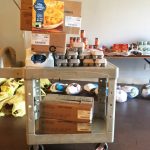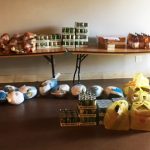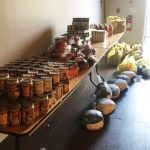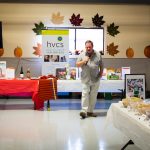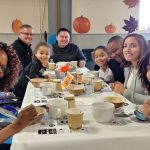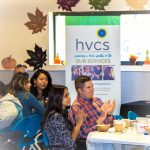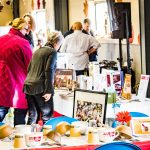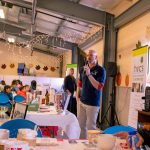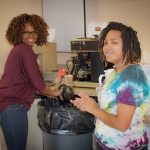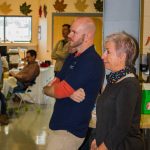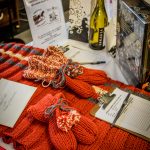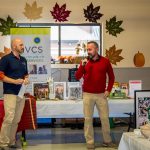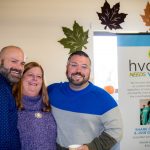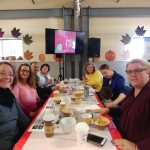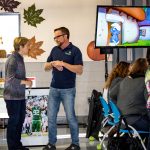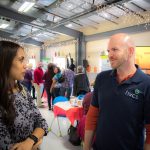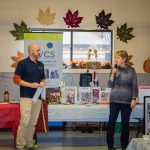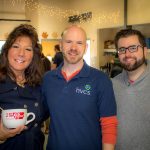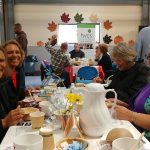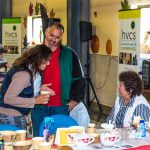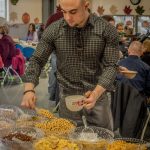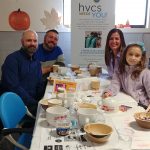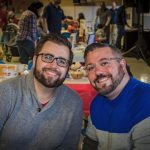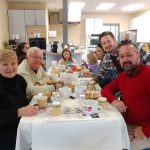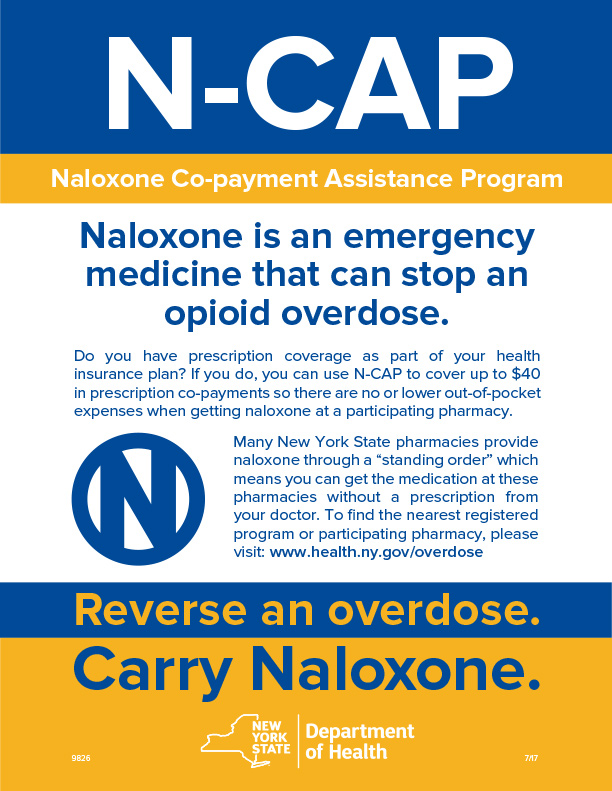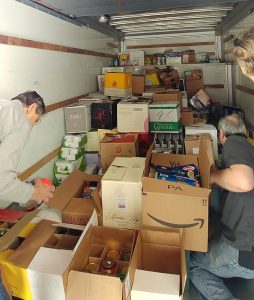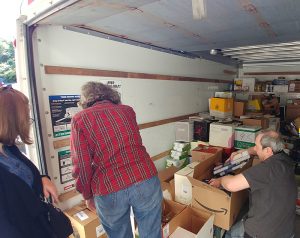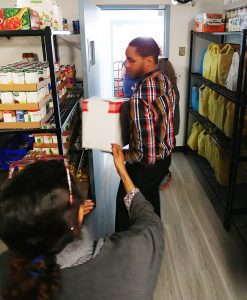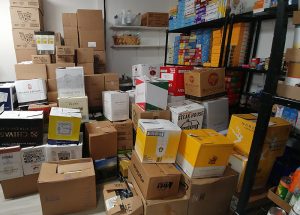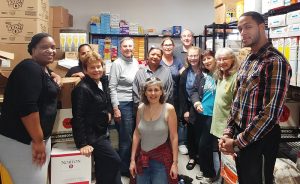Special thanks to St. James Antiochian Orthodox Church in Hyde Park for donating twelve full Thanksgiving dinners to some of our Health Home clients. It looks like they thought of everything! We are so grateful for your support, and for thinking of our clients at this special time of year.
St. James Antiochian Orthodox Church in Hyde Park Donates Thanksgiving Dinners
November 21st, 2017#GivingTuesday is almost here!
November 15th, 2017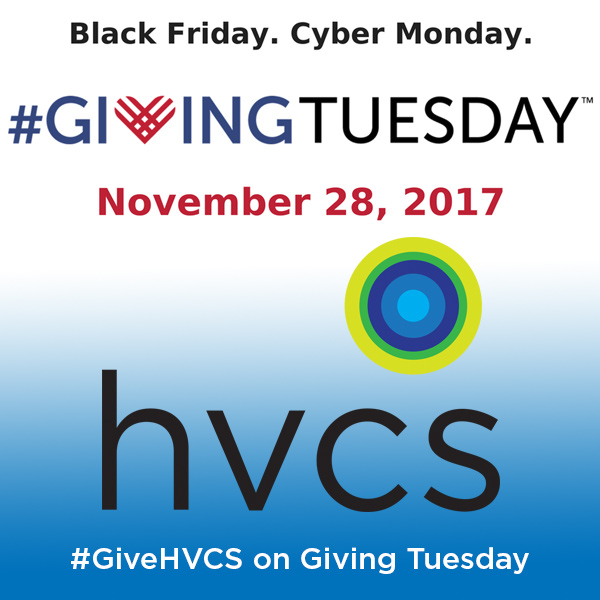 Giving Tuesday is a national day of fundraising set for the Tuesday after Thanksgiving (and after Black Friday, Small Business Saturday, and Cyber Monday). HVCS and many other charities will be using social media to ask supporters for donations to help us carry out our mission, and it ties into our overall end-of-year annual appeal.
Giving Tuesday is a national day of fundraising set for the Tuesday after Thanksgiving (and after Black Friday, Small Business Saturday, and Cyber Monday). HVCS and many other charities will be using social media to ask supporters for donations to help us carry out our mission, and it ties into our overall end-of-year annual appeal.
This year, Giving Tuesday is on November 28th.
You can help by making a donation to support HVCS’ food and nutrition programs, substance abuse programs, or HIV prevention efforts.
You can also pitch in by creating and sharing Giving Tuesday content on social media.
1) Please print out this sign;
2) Hold it up, give a big smile, and snap a pic;
3) OR, use the “GT_HVCS_Teaser” image provided at right, if you don’t want to take a selfie.
4) Next, post it on your social media profile and use the hashtag #GiveHVCS (you can also include the tag #GivingTuesday). Hashtags work on Facebook, Twitter and Instagram. It’s also great if you add in a sentence or two about your role at the agency.
5) Add in the link to our donation page: www.hudsonvalleycs.org/donate.
6) Or, if you’re on Facebook: ask people to visit the Hudson Valley Community Services page and use the Donate button. ***Facebook will MATCH all donations made to us via our Donate button on Nov 28th, up to $1,000 total for the agency!
Friends and family members are welcome to get in on the action too! The more the merrier—and the stronger our campaign.
Sample posts:
Facebook:
Today is #GivingTuesday and I’m asking you to #GiveHVCS. We improve the quality of life for thousands of Hudson Valley residents living with chronic illnesses, and your donation enables us to help more people and provide more services. Use the Donate button on @Hudson Valley Community Services and Facebook will match your donation!
Twitter:
It’s #GivingTuesday & I want you to donate to @HudsonValleyCS. Help us serve more local people w/ chronic illness. #GiveHVCS www.hudsonvalleycs.org/donate
Instagram:
Today is #GivingTuesday and I’m asking you to #GiveHVCS. We improve the quality of life for thousands of Hudson Valley residents living with chronic illnesses, and your donation enables us to help more people and provide more services. Please donate today via the profile link at @HVCSNY.
Photos From The Most Important Meal
November 6th, 2017Thanks to everyone who made our new fundraising event, The Most Important Meal, a success! Photos by Anthony Accomando and Ryan Judge.
NYS Announces New Program for Low- or No-Cost Naloxone Access
October 23rd, 2017For individuals with prescription coverage through their health insurance plans, this program will cover the cost of co-payments for naloxone up to $40 so there are no or lower out-of-pocket expenses when accessing naloxone at participating pharmacies. All Medicaid Managed Care Plans cover at least one formulation of naloxone, and the vast majority of private insurance plans also cover naloxone.
There are 2,000 pharmacies throughout the State who dispense naloxone with a physician standing order. Individuals getting naloxone at these pharmacies do not need a prescription. There is no individual enrollment requirement to use N-CAP. Maximizing pharmacy distribution increases access to naloxone.
For a directory of pharmacies with standing orders, please access the link below:
https://www.health.ny.gov/diseases/aids/general/opioid_overdose_prevention/directories.htm
This directory is updated monthly.
Individuals who cannot access naloxone from pharmacies will continue to access naloxone through registered programs including individuals using naloxone in the line of duty and people who are uninsured.
Additional information regarding N-CAP can be found at: www.health.ny.gov/overdose.
Woodlands Community Temple Organizes Food Drive for HVCS
October 2nd, 2017Woodlands Community Temple in Greenburgh, NY organized a food drive for HVCS’ emergency food closets on Sunday, October 1st. Thanks to everyone who donated and the volunteers who brought a delivery truck full of food to our Hawthorne office!
- The congregation collected enough food to fill a delivery truck.
- Unpacking the delivery truck at HVCS’ Hawthorne food pantry.
- Naomi and Cris, from our THRIVES team, help unload and sort boxes of donated food.
- Woodlands’ food drive results fill our food pantry.
- Woodlands Community Temple congregation members pose with HVCS’ THRIVES Nutrition program staffers.
New Online Donation Methods to Support HVCS
September 21st, 2017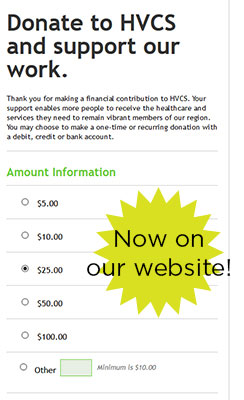 According to a recent survey of our supporters, 69% say they prefer to donate to HVCS online. We’ve responded by upgrading our website’s Donate page and by adding a new way to easily donate on Facebook.
According to a recent survey of our supporters, 69% say they prefer to donate to HVCS online. We’ve responded by upgrading our website’s Donate page and by adding a new way to easily donate on Facebook.
Now when you visit our Donate page, you’ll find a more robust online donation box where you can securely make a contribution to us, without jumping to another website or needing to enter any log-in info. And, for the first time, you can set up a recurring contribution–weekly, monthly or quarterly! A recurring donation is an easy, stress-free way to show your support for HVCS’ work throughout the Hudson Valley. (Plus, 10% of you said you’d like to make monthly donations to us.)
We’ve also been verified to receive donations directly through our Facebook page–just click on the Donate button at the top of our page. You can also easily set up your own fundraiser for us and collect donations for HVCS from your online friends. Kudos to volunteer Matt for turning his birthday into a fundraiser for us!
If you have any questions about these new methods, please contact us–we’re here to help!
New Prevention Program for Women of Color Coming Soon
September 21st, 2017HVCS is launching a new infectious disease prevention program this December specifically for women of color. Our new Women’s Services Program will help prevent new HIV, STD, and hepatitis C infections among minority women in Dutchess, Orange, Rockland and Westchester counties. The program aligns with New York State’s “End the Epidemic” plan to increase the number of women who know their HIV/STD/HCV status and increase the number of women linked to medical care.
The Women’s Services Program will use a trauma-informed approach to outreach and prevention, since many women at high risk for these infections live with traumatic pasts or present-day circumstances, including abuse, homelessness, poverty, and immigrant status.
Our initial contract will run for five years, and we aim to serve at least 300 women each year. We look forward to sharing more news about this exciting and important new program in the future.
NYS Becomes 1st in Nation to Offer Low- or No-Cost Naloxone
August 9th, 2017From a press release issued by Gov. Cuomo on Monday, August 7, 2017
GOVERNOR CUOMO ANNOUNCES NO-COST OR LOWER-COST NALOXONE AVAILABLE AT PHARMACIES ACROSS NEW YORK
First-in-the-Nation Program Offers Co-Payment Assistance For Medicine to Reverse Opioid Overdoses Beginning August 9, 2017
Expands State’s Aggressive Efforts to Fight the Opioid Epidemic
Governor Andrew M. Cuomo today announced a first-in-the-nation program to provide no-cost or lower-cost naloxone at pharmacies across New York. Beginning August 9, 2017, individuals with prescription health insurance coverage, including Medicaid and Medicare, will receive up to $40 in co-payment assistance, resulting in reduced cost or no cost for this lifesaving medicine. Uninsured individuals and individuals without prescription coverage will still be able to receive naloxone at no cost through New York’s network of registered opioid overdose prevention programs.
“This first-in-the-nation program will help put this lifesaving treatment in more hands and is one more prong in this administration’s efforts to battle heroin and opioid abuse,” Governor Cuomo said. “This is one more step toward a stronger, healthier New York for all.”
Naloxone is a medicine used to reverse opioid overdoses. Reducing the cost of this lifesaving medication builds on Governor Cuomo’s previous action to make naloxone available in pharmacies without a prescription which began in January 2016. Previously, New Yorkers could only receive naloxone with a prescription or through a registered opioid overdose prevention program.
As of August 9, 2017, New Yorkers can find co-payment information at pharmacy counters across the state and at: www.health.ny.gov/overdose. Individuals should provide this information to the pharmacist when asking for naloxone in order to receive it with no or lower out-of-pocket expense. The Naloxone Co-payment Assistance Program is funded by New York State’s Opioid Overdose Prevention Program.
Additionally, through New York’s network of registered opioid overdose prevention programs, uninsured individuals and individuals without prescription coverage will be able to receive naloxone at no cost. A full list of these programs is available here.
In the 2017 State Budget, Governor Cuomo invested over $200 million to fight the heroin and opioid epidemic. This unprecedented support is directed at prevention, treatment and recovery programs that address chemical dependency, expand residential service opportunities and promote public awareness and education.
Naloxone Saves Lives
Naloxone is a prescription medication used to reverse the effects of overdoses caused by heroin, prescription pain medication and other opioids. In 2014, state agencies began working together to develop a statewide program to train law enforcement personnel on how to administer naloxone. Since the trainings began, over 10,000 officers have been trained to administer the drug and 3,091 officers have been certified to train other officers.
Trained law enforcement officers across New York are saving lives with the naloxone they carry. Since April of 2014, 2,036 officers have administered naloxone to over 3,100 individuals, saving the lives of nearly 90 percent of the individuals that required assistance.
View a fact sheet on law enforcement naloxone training and usage, here.
New York State Department of Health Commissioner Dr. Howard Zucker said, “Naloxone is very effective at reversing opioid overdoses. Under Governor Cuomo’s leadership, New York State has taken comprehensive actions to stem the tide of opioid abuse, from increasing the number of treatment beds to making important health insurance reforms to eliminate barriers to accessing substance use services. The new copayment assistance program will make naloxone more available in communities across New York and save lives.”
New York State Office of Alcoholism and Substance Abuse Services Commissioner Arlene González-Sánchez said, “By guaranteeing affordable Naloxone to all New Yorkers, we will save thousands of lives and help repair the damage done to our communities by the opioid epidemic. Saving lives is the ultimate goal of all of our prevention, treatment, and recovery initiatives, and with this latest effort, Governor Cuomo is once again establishing New York State as a national leader in the field of addiction care.”
Chair of the Senate Committee on Alcoholism and Drug Abuse George Amedore said, “By increasing access to this effective remedy for drug overdoses, we are taking yet another step forward in combatting the heroin and opioid epidemic. I commend the Governor for removing barriers to help establish a stronger, healthier New York for generations.”
Chair of the Assembly Committee on Alcoholism and Drug Abuse Linda B. Rosenthal said, “New York’s communities are hard-struck by the heroin and opioid epidemic, and we must turn the tide by preventing more overdose deaths. Governor Cuomo’s plan to expand access to lifesaving naloxone through a new low-cost or no-cost co-payment system will help those struggling with this disease. By increasing access to Naloxone and cutting costs related to this lifesaving medication, New Yorkers in every corner of the state will be better equipped to save lives and help people receive the treatment they need. I look forward to working closely with the Administration to continue expanding access to overdose prevention and greater treatment options.”
Chair of the Senate Health Committee Kemp Hannon said, “The health and well-being of residents is our top priority. I look forward to working with the Governor to bring this treatment to our most vulnerable men and women, so that communities will be empowered to save the lives of thousands.”
Harm Reduction Coalition Medical Director Dr. Sharon Stancliff said, “This program will dramatically increase access to naloxone for people we haven’t easily reached. These include patients being treated for pain, loved ones of people returning from drug treatment or incarceration and people at risk in rural areas. This is a crisis and New York’s copayment assistance program adds to the solution.”
###
New Substance Abuse Program Coming to Sullivan County
August 9th, 2017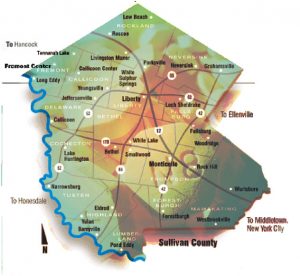 HVCS has received a grant from the NY State Department of Health to create what is called a Drug Users Health Hub for opiate users in Sullivan County. This new program, which we are calling the Hub, will help reduce opioid use and overdoses while improving clients’ general health. The funds will enable us to hire a physician and nurses to write Buprenorphine prescriptions and offer crisis visits, relapse prevention and wound care in our Monticello office.
HVCS has received a grant from the NY State Department of Health to create what is called a Drug Users Health Hub for opiate users in Sullivan County. This new program, which we are calling the Hub, will help reduce opioid use and overdoses while improving clients’ general health. The funds will enable us to hire a physician and nurses to write Buprenorphine prescriptions and offer crisis visits, relapse prevention and wound care in our Monticello office.
We are anxious to get to work with new staff positions and resources so that we can reduce the number of opioid overdoses and get more people into treatment. This program is also exciting because it will allow us to provide actual medical care as a stand-alone service, which is something HVCS has never done before.
The Hub will work in tandem with our other substance abuse treatment programs, the Syringe Exchange Program and Project ReachOut.
Buprenorphine–What’s That?
Staff in this program will be able to prescribe Buprenorphine to treat opioid and heroin addiction. It relieves drug cravings without producing the same high as other opioid drugs. The program nurses will also provide relapse interventions and monitor clients so they can access the services they need.
Homegrown Fundraisers: You Can Be a Fundraising Superstar for HVCS!
July 27th, 2017We’re sharing this article from The Chronicle of Philanthropy’s May issue because it’s in sync with a new initiative we’re starting here at HVCS. We’re encouraging our supporters to try their hand at a third-party fundraiser–which really means a small, personal fundraising event that you throw or do for your circle of friends and family. A third-party event can be a fantastic way to help HVCS’ clients without a ton of planning, worrying and overhead. From holding a potluck supper in your home to booking a paint-and-sip charity night to going on a hike, you can turn any event into a fundraiser with a little ingenuity. Check out our new guide to third-party events, and read on for more ideas.
Weddings. Birthday parties. Bike rides. Bake sales. Pub crawls.
More groups than ever are offering online tools to help supporters raise money through a widening variety of events, activities, or challenges that they conceive, organize, and manage themselves.
Paragliding all over the world? Why not raise money while you do it?
Giving up drinking for a month? Let’s set up a fundraising page for that.
The online tools make it easy for people to create their own pages and share them on social media or through email — creating new groups of supporters for nonprofits in the process.
Charities say they are facilitating these fundraising options to keep up with supporters’ shifting habits. Platforms like GoFundMe allow people to raise money in almost any way they want to, and nonprofits say they need to be just as flexible.
New platforms like DonorDrive and Blackbaud’s Everydayhero have allowed charities large and small to register these do-it-yourself events at low cost. For example, Everydayhero is free for nonprofits that use Blackbaud’s TeamRaiser software — which helps people raise money for charity through events organized by nonprofits — and about $1,000 for those that don’t. There’s also an administrative fee, usually around 5 percent, per transaction.
While the amounts raised usually are only a sliver of most charities’ overall contributions, grass-roots fundraising events offer big potential for acquiring new supporters. Their promise is limited only by nonprofits’ willingness and ability to help.
“It’s an emerging trend, fueled by technology and changes in how people communicate and run their lives in the digital age,” says David Hessekiel, president of the Peer-to-Peer Professional Forum, which provides resources for nonprofits that run events in which supporters raise money on behalf of nonprofit organizations.

Fast-Growing Trend
Just a decade ago, most nonprofits were cautious about liability issues related to outside supporters using logos and marketing materials in ways that might embarrass the organization, says Mr. Hessekiel.
Trailblazers included the St. Baldrick’s Foundation, which put on head-shaving events to support children’s cancer research, and Movember, which urges men to grow mustaches to raise funds for male health efforts. The St. Baldrick’s events raised $34.9 million in 2016, and Movember raised $17.2 million.
Those organizations were soon joined by other nonprofits big enough to have the staff and expertise to promote and oversee DIY events.
“For bigger charities, it’s pretty much expected now,” says Kevin Scally, director of digital marketing for Smile Train, which launched a donor platform last November with new features for its DIY fundraisers.
The technology boom has allowed smaller players to join the action in recent years using an expanding and diverse array of low-cost tools. However, the money from homegrown fundraisers doesn’t come free or without effort: Many groups devote significant staff time and marketing dollars to help supporters with their campaigns.
“There’s been a lot of disappointment” for groups that think DIY events generate easy money, says Mr. Hessekiel.
Attracting Younger Donors
Smile Train, a group that instructs doctors in how to help children in poor countries who need surgery to correct cleft lip, allows supporters to build profiles on its website that resemble social-network pages. Through the profiles, supporters can start their own fundraising campaigns and add a video, photos, and a description of their event. They can also comment on other people’s pages and share their fundraising events on Facebook, Twitter, and other social-media sites.
If the grass-roots event gets offline contributions, those can be logged into the online system to show gratitude to the donor.
So far, DIY fundraisers make up only a small percentage of the organization’s support. But Mr. Scally says it’s still vital to provide a way for Smile Train to accommodate anyone who wants to raise money. The organization hopes its DIY program will attract younger donors, he says. It seems to be doing just that; 48 percent of Smile Train’s DIY organizers are millennials, and 33 percent are from Generation X.
On the charity’s website, people can choose from a range of options, like athletic events or birthday celebrations in which guests are asked to give to Smile Train. They can also select the “get creative” option and come up with their own idea.
“It’s really important in today’s day and age to have a set of tools where people can go on and create things on their own,” Mr. Scally says. “You know how easy it is to set up a GoFundMe page. You know how easy it is to set up a Facebook profile. We tailor our tools to be similar to that type of sign-up process — where it’s quick, it’s easy, it’s fun.”
Among its DIY events posted online:
- Last year, a couple from Edison, N.J., raised $1,725 during a housewarming party.
- A yoga instructor in West End, N.C., donated $6,100 — a percentage of revenue from her class — to Smile Train.
- A couple from Saratoga Springs, N.Y., has committed to raise money every year until their infant son, who has a cleft lip, turns 18. Their goal: $175,000.
Banners and Balloons
Some organizations are asking supporters to start DIY events as part of larger campaigns.
The Alzheimer’s Association, for instance, asks people to organize their own events for its “Longest Day” campaign. Many of the events are held on the summer solstice, although people can raise money year-round. The campaigns run the gamut: rides, hikes, climbs, bowling, golfing, bridge tournaments. On June 20 last year, a supporter wrote poems on his blog from sunrise to sunset in honor of his wife, who suffers from Alzheimer’s. He raised a little more than $400.
Longest Day events raised almost $4 million in 2016 — the second-biggest peer-to-peer fundraising campaign for the nonprofit after its signature Walk to End Alzheimer’s. Longest Day is expected to raise even more this year, says Donna McCullough, the charity’s chief development officer.
Part of the reason for the campaign’s success, she says, is that supporters can access items like banners, balloons, and cups with the campaign’s logo to use in their events. The drive’s Facebook page is littered with people wearing “Longest Day” T-shirts at their individual events.
“It unites them in a common goal, and it really gives them a sense of joining the Alzheimer’s movement,” Ms. McCullough says.
Tips and Webinars
Many groups that have a DIY program provide tips and other resources for people raising money.
Water Mission, for instance, gives a DIY-fundraising tool kit to campaigns with goals of raising between $10,000 and $30,000. The clean-water charity’s kit includes customizable posters and fliers, a news-release template, and a fundraising tip sheet.
For World Vision’s Global 6K for Water drive, to be held May 6, the aid charity held regular webinars to educate people on the cause and talk about challenges and advice for hosting a six-kilometer walk on behalf of the organization. The webinars helped “create a sense of community early on,” says John Overy, director of digital marketing for World Vision, by making supporters feel like they were part of a large campaign.
Tending the Grass Roots
Many nonprofits have failed to provide enough help to DIY fundraisers to take full advantage of what they have to offer, experts say. Small groups in particular struggle to find the resources they need to make the programs successful.
For small groups that want to try peer-to-peer fundraising, however, DIY events may be a good low-cost alternative to hosting large runs or walks, says Mr. Hessekiel. Small organizations need to assess how much staff time they can devote to the program and should keep their expectations modest.
“Nobody is going to raise — other than in fluky situations — huge amounts of predictable, long-term money unless that are able to dedicate staff in order to make these programs really sing,” Mr. Hessekiel says.
Organizations with growing grass-roots programs tend to spread among several staff members the work of monitoring DIY platforms, thanking organizers, and answering their questions — or they have dedicated a full-time employee to handle most of those tasks.
Still, even large organizations say keeping up with all the events can be challenging.
“I’m a one-man shop,” says Megan Rouse, who has managed Susan G. Komen’s DIY program since last July. She says she spends more than a third of her time on the phone daily, mostly providing guidance and encouragement to organizers or trying to rouse dormant campaigns.
DIY events brought in $900,000 in Komen’s 2016 fiscal year; in fiscal 2017, which ended March 31, the breast-cancer charity raised $1.6 million. “I truly believe that is because of the customer service and building those relationships — talking to people, making sure they feel comfortable,” Ms. Rouse says.
Water Mission has tried to systematize its approach, developing what it calls a “decision matrix” that outlines what kinds of assistance each fundraiser will get from the organization.
For instance, an event with the potential to collect more than $30,000 has a staff member assigned as a contact and gets help with custom marketing materials, among other assistance.
“We only have really two people on our staff that are in that DIY and event-fundraising space, and we were running them ragged” before adopting the matrix, says Lisa Cottingham, the organization’s former director of development, who left in April to pursue consulting. “We had to come up with a way to allocate resources based on what we knew from experience and what we saw going forward.”
Marketing Boosts
For many organizations, promotional efforts are key to expanding their grass-roots campaigns. On its homepage, Smile Train links to its DIY registration page, and it promotes campaigns on its social-media accounts.
World Vision also promotes campaigns on social media and provides information about the program in its newsletters and in emails to current donors. Sometimes, Mr. Overy says, the charity’s staff battle over which program is going to be touted in which space and how often.
Those who run DIY programs need to stick up for them, he says. “You have to be an advocate and fight for marketing opportunities.”
Another major challenge has been retaining donors who give to a friend’s or loved one’s campaign but don’t organize the event themselves. The mind-set of those donors is often, “I’m helping a friend. I’m helping a cause. I’m not giving out of motivation to help the charity,” says Mr. Overy.
For now, World Vision sends major-gifts Canada fundraisers information about donors who make sizable contributions to DIY campaigns so those donors will get personal attention, he says. Smaller donors get an initial email thanking them for their gift, then are put in the same fundraising email and messaging streams that serve all one-time donors, he says.
For Ms. Rouse at Susan G. Komen, retaining those who organize events is more important. After all, they are the ones who are going to keep their friends and relatives giving.
To keep grass-roots fundraisers on board, she often calls people who have led past campaigns to ask if they are still going to participate. Sometimes she reregisters campaigns while she’s on the phone.
She sums up the message of the phone calls: “I know who you are, and I want you back.”


